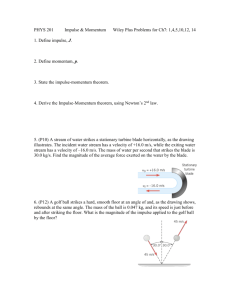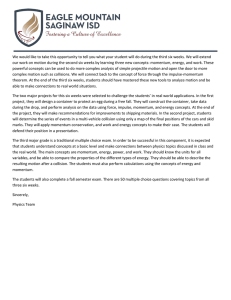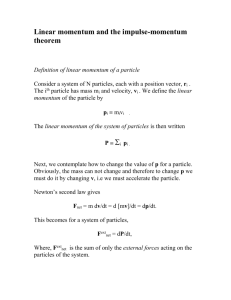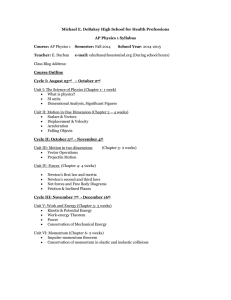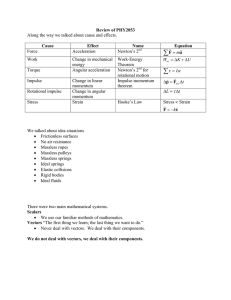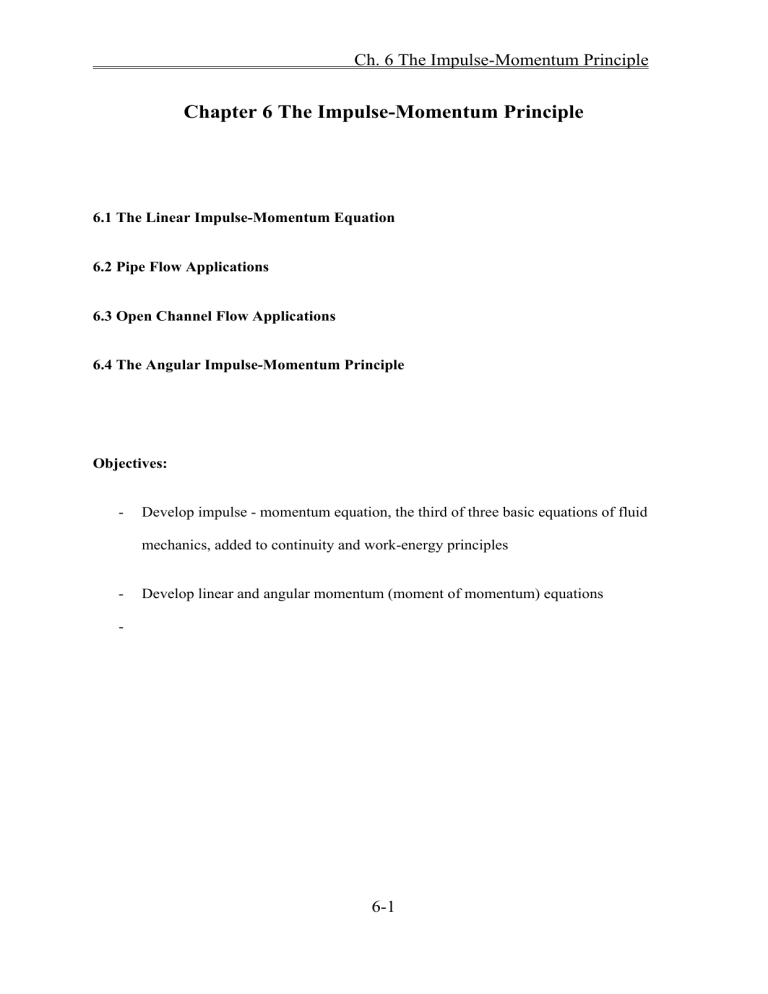
Ch. 6 The Impulse-Momentum Principle Chapter 6 The Impulse-Momentum Principle 6.1 The Linear Impulse-Momentum Equation 6.2 Pipe Flow Applications 6.3 Open Channel Flow Applications 6.4 The Angular Impulse-Momentum Principle Objectives: - Develop impulse - momentum equation, the third of three basic equations of fluid mechanics, added to continuity and work-energy principles - Develop linear and angular momentum (moment of momentum) equations - 6-1 Ch. 6 The Impulse-Momentum Principle 6.0 Introduction • Three basic tools for the solution of fluid flow problems Impulse - momentum equation Continuity principle Work-energy principle •Impulse - momentum equation ~ derived from Newton's 2nd law in vector form F ma Multifly by dt F dt madt d (mvc ) d F ( mvc ) dt where vc velocity of the center of mass of the system of mass mvc linear momentum 6-2 Ch. 6 The Impulse-Momentum Principle m dm sys vc 1 vdm m sys ( F )dt impulse in time dt - Define the fluid system to include all the fluid in a specified control volume whereas the Euler equations was developed for a small fluid system - Restrict the analysis to steady flow - Shear stress is not explicitly included - This equation will apply equally well to real fluids as well as ideal fluids. - Develop linear and angular momentum (moment of momentum) equations - Linear momentum equation: - Angular momentum equation: calculate line of action of the resultant forces, rotating calculate magnitude and direction of resultant forces fluid machinery (pump, turbine) 6-3 Ch. 6 The Impulse-Momentum Principle 6.1 The Linear Impulse – Momentum Equation Use the same control volume previously employed for conservation of mass and work-energy. For the individual fluid system in the control volume, d d F ma dt mv dt vdV (a) Sum them all F ext sys d d vdV vdV dt dt sys i v for momentum/mass Use Reynolds Transport Theorem to evaluate RHS d dE vdV i v dA v v dA v v dA (b) dt dt sys c.s. c. s .out c . s .in where E = momentum of fluid system in the control volume 6-4 Ch. 6 The Impulse-Momentum Principle i v momentum per unit mass Because the streamlines are straight and parallel at Sections 1 and 2, velocity is constant over the cross sections. The cross-sectional area is normal to the velocity vector over the entire cross section. ∴ In Eq. (b) v v dA v v n dA v vdA V 2 2Q2 c. s.out c.s.out c.s.out v Q v v dA v v n dA V 1 1Q1 c.s.in c.s.in v By Continuity eq: Q11 Q2 2 Q ∴ R. H. S. of (b) Q V2 V1 (c) Substitute (c) into (a) F Q V 2 V1 (6.1) In 2-D flow, F Q V2 x V1 x (6.2a) F Q V2 z V1z (6.2b) x z 6-5 Ch. 6 The Impulse-Momentum Principle General form in case momentum enters and leaves the control volume at more than one location: F Q v out Q v in (6.3) - The external forces include both normal (pressure) and tangential (shear) forces on the fluid in the control volume, as well as the weight of the fluid inside the control volume at a given time. - Advantages of impulse-momentum principle ~ Only flow conditions at inlets and exits of the control volume are needed for successful application. ~ Detailed flow processes within the control volume need not be known to apply the principle. 6-6 Ch. 6 The Impulse-Momentum Principle 6.2 Pipe Flow Applications Forces exerted by a flowing fluid on a pipe bend, enlargement, or contraction in a pipeline may be computed by a application of the impulse-momentum principle. • The reducing pipe bend Known: flowrate, Q; pressures, p1 , p2 ; velocities, v1 , v2 Find: F (equal & opposite of the force exerted by the fluid on the bend) = force exerted by the bend on the fluid 6-7 Ch. 6 The Impulse-Momentum Principle • Pressures: For streamlines essentially straight and parallel at section 1 and 2, the forces F1, and F2 result from hydrostatic pressure distributions. If mean pressure p1 and p2 are large, and the pipe areas are small, then F1 p1 A1 and F2 p2 A2 , and assumed to act at the centerline of the pipe instead of the center of pressure. • Body forces: = total weight of fluid, W • Force exerted by the bend on the fluid, F = resultant of the pressure distribution over the entire interior of the bend between sections 1&2. ~ distribution is unknown in detail ~ resultant can be predicted by Impulse-momentum Eq. Now apply Impulse-momentum equation, Eq. (6.2) (i) x-direction: 6-8 Ch. 6 The Impulse-Momentum Principle Fx p1 A1 p2 A2 cos Fx Q V2 x V1x Q V2 cos V1 Combining the two equations to develop an expression for Fx Fx p1 A1 p2 A2 cos Q (V1 V2 cos ) (6.4.a) (ii) z-direction Fz W p2 A2 sin Fz Q V2 z V1z Q V2 sin 0 Fz W p2 A2 sin Q V2 sin (6.4.b) If the bend is relatively sharp, the weight may be negligible, depending on the magnitudes of the pressure and velocities. 6-9 Ch. 6 The Impulse-Momentum Principle [IP 6.1] 300 l/s of water flow through the vertical reducing pipe bend. Calculate the force exerted by the fluid on the bend if the volume of the bend is 0.085 m3. 590.6 N Given: Q 300 l s 0.3 m3 s ; Vol. of bend 0.085 m3 A1 4 (0.3)2 0.071 m2 ; A2 4 (0.2)2 0.031 m 2 p1 70 kPa 70 103 N m2 1) Continuity Eq. Q AV 1 1 A2V2 V1 (4.5) 0.3 4.24 m/s 0.071 6-10 Ch. 6 The Impulse-Momentum Principle V2 0.3 9.55 m/s 0.031 2) Bernoulli Eq. between 1 and 2 p1 V12 p2 V22 z1 z2 2g 2g 70 103 (4.24) 2 p2 (9.55) 2 0 1.5 9,800 2(9.8) 9,800 2(9.8) p2 18.8 kPa 3) Momentum Eq. Apply Eqs. 6.4a and 6.4b Fx p1 A1 p2 A2 cos Q (V1 V2 cos ) Fz W p2 A2 sin Q V2 sin F1 p1 A1 4948 N F2 p2 A2 18.8 103 0.031 590.6 N W (volume) 9800 0.085 833 N 6-11 Ch. 6 The Impulse-Momentum Principle Fx 4,948 (590.6) cos120 (998 0.3)(4.24 9.55cos120 ) 7,942 N Fz 833 (590.6)sin120 (998 0.3)(9.55sin120 0) 3,820 N F Fx2 Fz2 8,813 N tan 1 Fz 25.7 Fx 6-12 Ch. 6 The Impulse-Momentum Principle • Abrupt enlargement in a closed passage ~ Real fluid flow The impulse-momentum principle can be employed to predict the fall of the energy line (energy loss due to a rise in the internal energy of the fluid caused by viscous dissipation) at an abrupt axisymmetric enlargement in a passage. Energy loss Consider the control surface ABCD assuming a one-dimensional flow i) Continuity Q AV 1 1 A2V2 Result from hydrostatic pressure distribution over the area ii) Momentum → For area AB it is an approximation because of the dynamics of eddies in the “dead water” zone. Fx p1 A2 p2 A2 Q (V2 V1 ) 6-13 Ch. 6 The Impulse-Momentum Principle ( p1 p2 ) A2 V2 A2 (V2 V1 ) g p1 p2 V2 (V2 V1 ) g (a) iii) Bernoulli equation p1 V12 p2 V22 H 2g 2g p1 p2 V22 V12 H 2g 2g (b) where H Borda-Carnot Head loss Combine (a) and (b) V2 (V2 V1 ) V22 V12 H g 2g 2g 2V22 2V1V2 V22 V12 (V1 V2 ) 2 H 2g 2g 2g 2g 6-14 Ch. 6 The Impulse-Momentum Principle 6.3 Open Channel Flow Applications • Applications impulse-momentum principle for Open Channel Flow - Computation of forces exerted by flowing water on overflow or underflow structures (weirs or gates) - Hydraulic jump - Wave propagation [Case 1] Sluice gate Shear force neglected is Consider a control volume that has uniform flow and straight and parallel streamlines at the entrance and exit Apply first Bernoulli and continuity equations to find values of depths y1 and y2 and flowrate per unit width q Then, apply the impulse-momentum equation to find the force the water exerts on the sluice gate 6-15 Ch. 6 The Impulse-Momentum Principle Fx Q (V2 V1 ) Discharge width per Fx F1 F2 Fx Q (V2 x V1x ) q V2 V1 where q Q discharge per unit width y1V1 y2V2 W Assume that the pressure distribution is hydrostatic at sections 1 and 2, replace V with q/y y12 y22 1 1 Fx q 2 ( ) 2 2 y2 y1 (6.6) [Re] Hydrostatic pressure distribution y1 y12 F1 hc A ( y1 1) 2 2 1( y1 )3 I 1 12 l p lc c y1 lc A y1 ( y 1) 6 1 2 Cp 1 1 1 y1 y1 y1 2 6 3 6-16 unit Ch. 6 The Impulse-Momentum Principle For ideal fluid (to a good approximation, for a real fluid), the force tnagent to the gate is zero. → shear stress is neglected. → Hence, the resultant force is normal to the gate. F Fx cos We don’t need to apply the impulse-momentum equation in the z-direction. [Re] The impulse-momentum equation in the z-direction Fz Q (V2 z V1z ) Fz FOB W Fz Q (0 0) Fz W FOB Non-uniform distribution 6-17 pressure Ch. 6 The Impulse-Momentum Principle [IP 6.2] For the two-dimensional overflow structure, calculate the horizontal component of the resultant force the fluid exerts on the structure Lift gate Ideal fluid • Continuity Eq. q 5V1 2V2 (4.7) • Bernoulli's equation between (1) and (2) V12 V22 0 5m 0 2m 2g 2g (5.7) Combine two equations V1 3.33 m s V2 8.33 m s q 5(3.33) 16.65 m3 s m 6-18 Ch. 6 The Impulse-Momentum Principle • Hydrostatic pressure principle 9.8 kN m3 y (5)2 122.5 kN m F1 hc A y 9.8 2 2 (2)2 F2 9.8 19.6 kN m 2 • Impulse-Momentum Eq. ( 1000 kg m ) 3 Fx 122,500 Fx 19,600 (1000 16.65)(8.33 3.33) Fx 19.65 kN m [Cf] What is the force if the gate is closed? 6-19 Ch. 6 The Impulse-Momentum Principle Jamshil submerged weir (Seo, 1999) Jamshil submerged weir with gate opened (Q = 200 m3/s) 6-20 Ch. 6 The Impulse-Momentum Principle Bucket roller Jamshil submerged weir Model Test; Q = 200 m3/s (Seo, 1999) Jamshil submerged weir Model Test (Q = 5,000 m3/s) 6-21 Ch. 6 The Impulse-Momentum Principle [Case 2] Hydraulic Jump When liquid at high velocity discharges into a zone of lower velocity, a rather abrupt rise (a standing wave) occurs in water surface and is accompanied by violent turbulence, eddying, air entrainment, surface undulation. → such as a wave is known as a hydraulic jump Head loss due to hydraulic jump → large head loss (energy dissipation) turbulence, eddying, air entrainment, surface undulation in the hydraulic jump Neglect shear force Apply impulse-momentum equation to find the relation between the depths for a given flowrate Construct a control volume enclosing the hydraulic jump between two sections 1 and 2 where the streamlines are straight and parallel Fx F1 F2 y12 2 y22 2 q (V2 V1 ) where q flowrate per unit width 6-22 Ch. 6 The Impulse-Momentum Principle Substitute the continuity relations V1 q q ; V2 y1 y2 Rearrange (divide by ) q 2 y12 q 2 y2 2 gy1 2 gy2 2 Solve for y2 y1 8q 2 1 8V12 y2 1 1 1 3 1 1 y1 2 gy1 2 gy1 Set Fr1 V1 gy1 Fr2 V2 gy2 William Froude (1810~1879) where Fr Froude number Inertia Force Gravity Force V gy 6-23 (6.7) Ch. 6 The Impulse-Momentum Principle Then, we have y2 1 1 1 8Fr12 y1 2 (a) Fr1 1 : (b) Fr1 1 : (c) Fr1 1: Jump Equation critical flow y2 1 1 1 8 1 y1 2 y1 y2 No jump super-critical flow y2 1 y1 y2 y1 Hydraulic jump y2 y1 physically impossible sub-critical flow y2 1 y1 (∵ rise of energy line through the jump is impossible) Conclusion: For a hydraulic jump to occur, the upstream conditions must be such that V12 gy1 1 . 6-24 Ch. 6 The Impulse-Momentum Principle [IP 6.3] p. 199 ; Water flows in a horizontal open channel. y1 0.6 m q 3.7 m3 s m Find y2 , and power dissipated in hydraulic jump. [Sol] (i) Continuity q y1V1 y2V2 V1 3.7 6.17 m s 0.6 Fr1 V1 6.17 2.54 1 hydraulic jump occurs 9.8(0.6) gy1 (ii) Jump Eq. y2 y1 1 1 8Fr12 2 0.6 1 1 8(2.54)2 2 1.88 m 6-25 Ch. 6 The Impulse-Momentum Principle V2 3.7 1.97 m s 1.88 (iii) Bernoulli Eq. (Work-Energy Eq.) V12 V22 y1 y2 E 2g 2g 0.6 (6.17) 2 (1.97) 2 1.88 E 2(9.8) 2(9.8) E 0.46 m Power QE 9800 3.7 0.46 16.7 kW meter of width → The hydraulic jump is excellent energy dissipator (used in the spillway). 6-26 Ch. 6 The Impulse-Momentum Principle Pulsating jump E/E ~ 85% 6-27 Ch. 6 The Impulse-Momentum Principle [Case 3] Wave Propagation The velocity (celerity) of small gravity waves in a body of water can be calculated by the impulse-momentum equation. •small gravity waves ~ appears as a small localized rise in the liquid surface which propagate at a velocity a ~ extends over the full depth of the flow [Cf] small surface disturbance (ripple) ~ liquid movement is restricted to a region near the surface For the steady flow, assign the velocity under the wave as a’ From continuity 6-28 Ch. 6 The Impulse-Momentum Principle ay a ' y dy From impulse-momentum y2 2 y dy 2 2 ay a ' a (6.2a) Combining these two equations gives a 2 g y dy Letting dy approach zero results in a gy (6.8) → The celerity of the samll gravity wave depends only on the depth of flow. 6-29 Ch. 6 The Impulse-Momentum Principle 6.4 The Angular Impulse-Momentum Principle The angular impulse-momentum equation can be developed using moments of the force and momentum vectors V2z V2 V2x (x1, z1) (x2, z2) Fig. 6.8 Take a moment of forces and momentum vectors for the small individual fluid system about 0 d d r F ( r mv ) ( r d Vol v ) dt dt Sum this for control volume d r Fext ( r v ) d Vol. dt sys 6-30 (a) Ch. 6 The Impulse-Momentum Principle Use Reynolds Transport Theorem to evaluate the integral i rv dE d ( r v ) d Vol. i v dA C.S . dt dt sys C . S .out (r v) v dA C . S .in (r v) v dA (b) E moment of momentum of fluid system where i r v = moment of momentum per unit mass Restrict to control volume where the fluid enters and leaves at sections where the streamlines are straight and parallel and with the velocity normal to the cross-sectional area d r v d Vol r v dQ r ( ) . ( ) ( C.S .out C.S .in v) dQ dt sys Because velocity is uniform over the flow cross sections d r v dVol Q r V Q r ( ) . ( ) ( out out in Vin ) dt sys Q ( r V )out ( r V )in (c) where r position vector from the moment center to the centroid of entering or leaving flow cross section of the control volume 6-31 Ch. 6 The Impulse-Momentum Principle Substitute (c) into (a) ( r Fext ) M 0 Q ( r V )out ( r V )in (6.13) In 2-D flow, M 0 Q ( r2V2 t rV 1 1t ) (6.14) where Vt component of velocity normal to the moment arm r. In rectangular components, assuming V is directed with positive components in both x and zdirection, and with the moment center at the origin of the x-z coordinate system, for clockwise positive moments, M 0 Q ( z2V2 x x2V2 z ) ( z1V1 x x1V1z ) (6.15) where x1 , z1 coordinates of centroid of the entering cross section x2 , z2 coordinates of centroid of the leaving cross section For the fluid that enter or leave the control volume at more than one cross-section, M 0 ( Q rVt )out ( Q rVt )in 6-32 (6.16) Ch. 6 The Impulse-Momentum Principle [IP 6.6] Compute the location of the resultant force exerted by the water on the pipe bend. 590 N 8,813 N Assume that center of gravity of the fluid is 0.525 m to the right of section 1, and the forces F1 and F2 act at the centroid of the sections rather than at the center of pressure. Take moments about the center of section 1 M 0 Q ( z2v2 x x2v2 x ) ( z1v1x x1v1x ) For this case, x1 0, z1 0, x2 0.6, z2 1.5 T r (8,813) 0.525(833) 1.5(590cos60 ) 0.6( 590sin 60 ) (0.3 998) 1.5(9.55 cos60 ) 0.6(9.55 sin 60 ) r 0.59 m 6-33 Ch. 6 The Impulse-Momentum Principle [Re] Torque for rotating system d T (r F ) (r mv c ) dt Where T torque T dt torque impulse r mvc angular momentum (moment of momentum) r radius vector from the origin 0 to the point of application of a force [Re] Vector product (cross product) V F G -Magnitude: V F G sin -Direction: perpendicular to the plane of F and G (right-hand rule) If F , G are in the plane of x and y , then the V is in the z plane. 6-34 Ch. 6 The Impulse-Momentum Principle Homework Assignment # 6 Due: 1 week from today Prob. 6.1 Prob. 6.6 Prob. 6.14 Prob. 6.16 Prob. 6.30 Prob. 6.34 Prob. 6.36 Prob. 6.40 Prob. 6.55 Prob. 6.60 6-35
